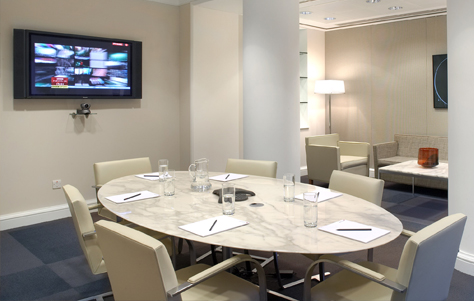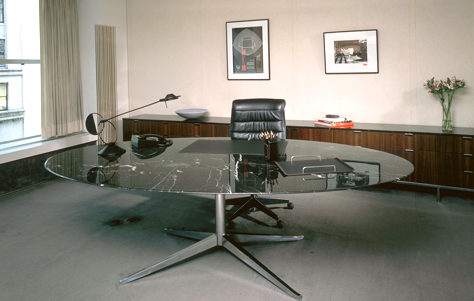
I have decided that before 2011 is out, I will buy actual office furniture for my home office. Hitherto, I’ve been working on a folding table from Staples — which actually worked great, as it allowed me to spread out multiple computers, peripherals, papers, and such. I never got around to buying an actual desk. Although, I will confess that I invested in a chair a couple of years ago, which might have been the best $800 I’ve ever spent.
So I start looking around for desks. And quickly ran into something interesting. Read on to follow along these random musings.
What Is Your Idea of an Executive Desk?
What I found is that doing a Google search for “executive desk” produced results that are largely of the following:

Or perhaps this:

Or if you’re inclined towards baronial mannerisms, and imagine that being the Vice President of Human Resources actually means that you’re the seventeenth Earl of Doomsbury, this is the desk for you:

Apart from the fact that all of these “executive desks” are ugly enough to warrant a U.N. human rights violation investigation, all of these desks imply a particular vision of what an “executive” is. All three desks are meant to evoke wealth, power, and prestige. They are intended, perhaps, to make the visitor sitting on the other side of such a desk feel either like a supplicant for a favor or a serf about to receive the royal commands. At the same time, the sheer mass of these things are like a fortress, as if the person sitting behind it is afraid the visitor might open fire, and needs Fortress Desk to serve as a refuge.
Granted, modern office furniture often features modular workstations, rather than these fortresses of oak and rosewood, but even these leave something to be desired:

Okay, so the modern executive isn’t quite as interested in being the Imposing Voice of God or the Duke of Financeshire, but now I’m even more forcefully reminded that the modern executive is, in a sense, just another computer operator. There is a whole side dedicated to the almighty computer monitor. It is practical, perhaps, but the furniture is, in a way, a reminder of what it is that we do. Which brings me to…
What Is Your Idea of an Executive?
If form follows function, then the type of work an “executive” actually does would dictate what her desk would look like.
If the executive spends most of her time saying No to people, then the first three desks, massive fortresses of wood and steel designed to intimidate any bold enough (or unfortunate enough) to have to approach them, would do very nicely.
If, on the other hand, your idea of an “executive” is “someone who spends a lot of time drafting reports to upper management (i.e., the People Who Say No For a Living) and making PowerPoint decks for presentations in large conference rooms” then that computer-desk-cum-receptionist-hutch would do very nicely indeed.
But is that what an “executive” is supposed to do?
I believe an executive, whatever his or her job title is, has two functions: (1) make decisions, and (2) lead. Everything else is secondary to those two. A junior executive makes small decisions (“Which vendor should I use to design our new banner ads?”); a senior executive makes big decisions (“What percentage of revenues should I devote to marketing?”). But both make decisions. That is the hallmark of an executive.
And then they lead others, whether they be subordinates, peers, vendors, upper management, or ill-defined stakeholders. The executive has to communicate the decision, explain the reasons, get at least some level of buy-in from other people, and then constantly manage budgets, schedules, people, resources, making hundreds or thousands of little decisions all along the way (including the decision to delegate to someone else), until she and the company either achieves success, or fails miserably, or as is usually the case, somewhere in between the two.
Along the way, she may need to write some reports. A PowerPoint or two or sixteen may be necessary. Saying No might be required. But none of those things adequately describe what she does as an executive. Because what she actually does is two things: make decisions, and lead people.
Which Leads Us Back To Desks…
The reason I wrote this post is that I was really surprised at my reaction to this desk:
 That, ladies and gentlemen, is the Knoll Oval Table Desk. First designed by Florence Knoll in 1961, this desk is first and foremost a table. Companies often use it as a small conference table, like this:
That, ladies and gentlemen, is the Knoll Oval Table Desk. First designed by Florence Knoll in 1961, this desk is first and foremost a table. Companies often use it as a small conference table, like this:

But what really moved me in a strange way, in a way I can’t really explain, is to see it used as an executive’s desk:

I actually said out loud to no one, “Yes!” when I saw this.
Yes, this is what I had in mind when I was thinking of an executive. Rather than hiding behind a fortress, this person is open and inviting. There is no visual power structure here; he and I are both equals sitting down at the same table (literally). No drawers on “his side” means no secret files, no secret documents, no secret agendas when we get together. The very shape means this executive’s desk is a place for people to meet, to converse, to communicate, to debate and argue, to convince, cajole, and ultimately come to understand the plan. There are no sides here, so taking sides would be pretty hard. There is no “you” vs. “them”; just “us”.
This is the way that work gets done in 21st century workplaces.
The desk also struck me as a place where decisions get made. Some of the most important decisions in my life were made around the dinner table: where to apply for college, whether to ask my girlfriend to marry me, whether to start a company. What better place to make decisions both large and small than around a table, even if it’s “my desk”?
And of course, it’s a stunningly beautiful piece of furniture.
Alas, I can’t justify spending $7,000 on a table/desk just yet — even one as perfect as this one. Plus, my home office is hardly the place I will be meeting with clients or convincing a whole lot of subordinates (which I do not have) on my grand plan. The idea, however, remains.
Those of you who do have real offices, where you have real executive jobs, leading other people and making decisions large and small… look at your desk. Does that form follow your function? If so, is that the function you really want to have? If not, why haven’t you changed either the desk or your job?
In the meantime, in case my wife reads this post… honey, if you’re wondering where our Ikea kitchen table disappeared to… now you know.
-rsh


15 thoughts on “Of Desks & Executives”
I love your take on the executive desk, and I love that desk. It’s been said that a round or oval dining table is more inspiring to conversation than a square or rectangle.
Have you seen Zuckerberg’s desk?
Rob – you are clueless about desks – clearly Hon is the desk for you! Duh…. http://www.hon.com/
What on earth would drive anyone to pay $7,000 for that desk?! It appears to be reproducible for far, far less than that. What am I missing? Thanks
Pretty sure that $5,000 of the $7,000 is the license to pay the estate of Florence Knoll. 🙂
Loved this message! I for one found very good luck furnishing my office at cb2.com – not all of it is necessarily office furniture (my printer, etc is on a cool rolling cart that I think was for a microwave (in case you need ideas for slipping more furniture while your wife isn’t looking 🙂
Yep, Rob..I like the way you think…that’s why I read your blog. As an “executive” at least that’s in my title..my job is to make sure everything is done and everyone else looks good…that’s why my desk does look like a work in progress all the time. I think of it as job security.
Great post. My most productive desk ever was a rectangular table. I choose it and the corner office because of the view of the CT woods which surrounded me. I did add a large white board behind me so I could swivel and write/draw on the wall…Those were the days…Now, I use an oval table, but it is a mere memory of things past. BTW, my rectangular desk was purchased for $1000 and when my (then) boss saw it, made many threats to have it shipped to him at “headquarters” In New York, I did some pretty good work on a hollow core door placed across two file cabinets…
Something like this? http://mred.vu/fSq7PU
Rob, back in my Interbrand Wood days my boss actually had that desk, and it was truly a thing of beauty. I’m convinced it really made a difference in what he was able to accomplish both from a management and creative standpoint. Have you ever thought of looking for a used one? I’ve seen several through the years on eBay and other sites. Here’s to one day having one of your own.
This one is almost large enough for my Tweetdeck view:
http://cache.gawkerassets.com/assets/images/17/2010/12/500x_4388295418_4f0db62357_b.jpg
from Lifehacker’s 2010 Popular Workspaces: http://lifehacker.com/5716499/most-popular-featured-workspaces-of-2010
Rob
I was possessed to shout Yes as soon as I saw the table in your post. Here’s where I found myself in pursuit of your new grown-up desk.
http://www.cb2.com/family.aspx?c=11020&f=3424
http://www.target.com/Tampa-Dining-Table/dp/B001E4OGQ0/ref=sc_qi_detailbutton
http://www.remodshop.com/tables/mcm-t-conferencedining-table/
http://www.remodshop.com/tables/chromcraft-dining-table/
http://houston.craigslist.org/fuo/2140383677.html
Good luck
kerry
one word … Ikea
Believe me, I’ve looked in Ikea. But this is an aspirational goal now. 🙂
Comments are closed.